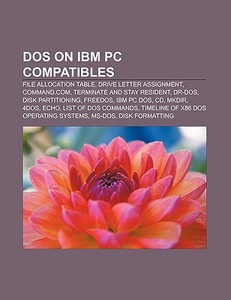
DOS on IBM PC compatibles
File Allocation Table, Drive letter assignment, COMMAND.COM, Terminate and Stay Resident, DR-DOS, Disk partitioning, FreeDOS, IBM PC DOS, Cd, Mkdir, 4
- Editore:
Books LLC, Reference Series
- EAN:
9781156436851
- ISBN:
1156436850
- Pagine:
- 104
- Formato:
- Paperback
- Lingua:
- Inglese
Descrizione DOS on IBM PC compatibles
Source: Wikipedia. Pages: 102. Chapters: File Allocation Table, Drive letter assignment, COMMAND.COM, Terminate and Stay Resident, DR-DOS, Disk partitioning, FreeDOS, IBM PC DOS, Cd, Mkdir, 4DOS, Echo, List of DOS commands, Timeline of x86 DOS operating systems, MS-DOS, Disk formatting, Batch file, VGA compatible text mode, Comparison of x86 DOS operating systems, DOSBox, DriveSpace, 86-DOS, AUTOEXEC.BAT, Disk Defragmenter, COM file, Virtual DOS machine, CHKDSK, Undeletion, Multiuser DOS, CONFIG.SYS, Redirection, MS-DOS API, Subst, Fdisk, Abort, Retry, Fail?, More, DOS Plus, Append, Debug, ANSI.SYS, Time and date, DOSKey, Attrib, MS-DOS Editor, Help, Partition type, PTS-DOS, DOSEMU, Double Tools for DoubleSpace, Rmdir, PC-MOS/386, Choice, XCOPY, SCANDISK, IO.SYS, Program Segment Prefix, Print, DOS Shell, PC booter, Microsoft Diagnostics, Ver, Bhole, Label, Pushd and popd, Net use, DOS MZ executable, Insight Debugger, Doscore, Find, SkyFireOS, WIN.COM, Tao exdos, Diskcopy, Vol, Ren, Loadhigh, Cls, HIMEM.SYS, MSDOS.SYS, Deltree, Sys.com, Bad command or file name, Exit, ETen Chinese System, Job File Table, FASTOPEN, DOS/V, Slowdown utility, Move, Microsoft File Compare, Share, Pcmicro, IBMBIO.COM, SISNE plus, IBMDOS.COM. Excerpt: File Allocation Table (FAT) is a computer file system architecture now widely used on many computer systems and most memory cards, such as those used with digital cameras. FAT file systems are commonly found on floppy disks, flash memory cards, digital cameras, and many other portable devices because of their relative simplicity. For floppy disks, the FAT has been standardized as ECMA-107 and ISO/IEC 9293. Those standards include only FAT12 and FAT16 without long filename support; long filenames with FAT is partially patented. The FAT file system is relatively straightforward technically and is supported by virtually all existing operating systems for personal computers. This makes it a useful format for solid-state memory cards and a convenient way to share data between operating systems. First implemented in Microsoft Standalone Disk BASIC with 8 bits table elements, the FAT was extended to 12 bits in 86-DOS. The name originates from the usage of a table which centralizes the information about which areas belong to files, are free or possibly unusable, and where each file is stored on the disk. To limit the size of the table, disk space is allocated to files in contiguous groups of hardware sectors called clusters. As disk drives have evolved, the maximum number of clusters has dramatically increased, and so the number of bits used to identify each cluster has grown. The successive major versions of the FAT format are named after the number of table element bits: 12, 16, and 32. The FAT standard has also been expanded in other ways while preserving backward compatibility with existing software. The initial version of FAT is now referred to as FAT12. Designed as a file system for floppy disks, it limited cluster addresses to 12-bit values, which not only limited the cluster count to 4078, but made FAT manipulation tricky with the PC's 8-bit and 16-bit registers. (Under Linux, FAT12 is limited to 4084 clusters.) The disk's size is stored as a 16-bit count of sectors












